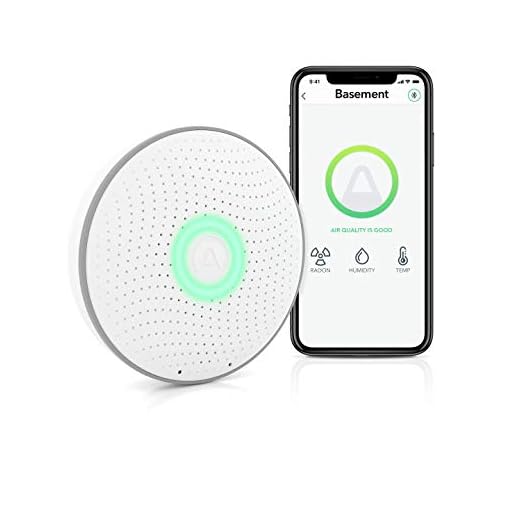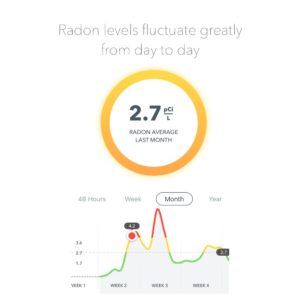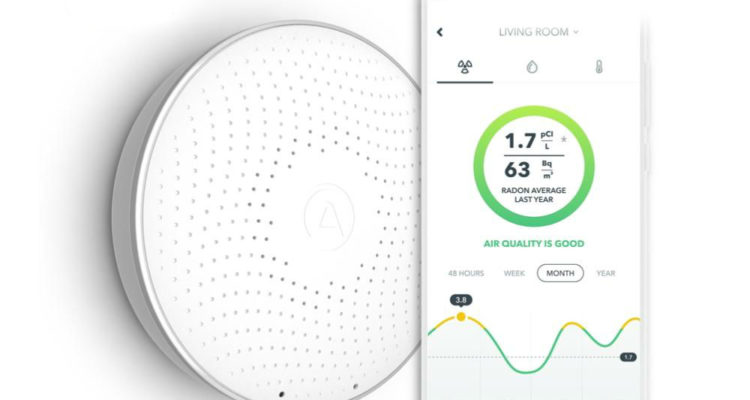Up until a year ago, I had not heard much about Radon. My home monitored smoke, carbon monoxide and even VOCs (volatile organic compounds). But when I was informed that I lived in a region with high levels of this gas, it was time get proactive.
Radon is an odorless, colorless, radioactive gas that is everywhere. It forms from the decay of radioactive elements in rocks, soil, and our water. Behind smoking, radon is the second leading cause of lung cancer in the United States
The Airthings Wave Radon Detector is a real-time radon detector that comes in at under $200. Now you might ask why not just get a $15 charcoal test kit? Radon levels fluctuate based on a number of factors. Thus passive monitoring doesn’t provide an accurate view of your home’s conditions over time. Plus, if you plan to test every few months, you’ll find an active monitoring solution paying for itself in no time.
Simple, functional design
My first take after unboxing the Wave was just how small it was. The size of your standard smoke detector, it has a modern looking white shell that is covered in tiny holes. An LED ring sits in the middle to give you status updates of your home.
The Wave runs on 2 AA batteries. Airthings claims this will give you a year and a half of use. At 9 months on mine, this seems like it might be accurate. A bracket kit is included, but the unit can also be placed flat on a table if you’d like to keep it simple.
No Wi-Fi, but Bluetooth is up to the task
One thing I wasn’t aware of before purchasing was the Airthings Wave connects via Bluetooth to your phone. I had assumed at the high price point, a Wi-Fi chip would be standard. This is a perplexing design choice for a device that will be a fixture in your home.
Despite that, the Bluetooth works fine. Range seems to be around 40 feet in my home and it does work its way through floors. The worst case scenario is you’ll have to bring your phone near it every week so it can sync up data.
There have been some complaints online about pairing, but that wasn’t the case with me. My phone’s Bluetooth synced right away to the Wave and hasn’t had issues grabbing data since. Their app requires some basic information to create an account, but that’s nothing new.

Accurate from what I can tell
Without a bunch of expensive equipment at my disposal, it can be tough to tell you how accurate the Airthings Wave is. I did purchase a cheaper charcoal test kit which came within a tenth of a point to the Wave. But my radon levels have been consistently low so I can’t be certain how it handles higher levels.
The Wave needs at least week to settle in (a month might be more accurate). Airthings states you can get a reading within an hour, but I found the radon levels fluctuate greatly over the first few days. So much so that I was on the verge of calling out some expensive professionals. But after reading about the need to calibrate to its surroundings, it settled in on some more realistic readings.
Radon is tested using pCi/L (picoCuries per liter of air) in the home. And you can get a quick snapshot of your home’s situation by waving your hand in front of the device (get why it’s called the Wave now?). Green means healthy levels, yellow is for temporarily high levels, and red is dangerous.
Besides testing for radon, the device gathers temperature and humidity information. Since this unit is in my basement, there isn’t a huge need for it on my end. But if you do plan to place them around the house, it can be helpful to see the historical data. Both settings came in accurate when set next to a temperature monitor.
App and web module are impressive
The Airthings Wave app (available on iOS and Android) is both simple to operate and quite intuitive. You’re immediately given a snapshot of your current situation upon launch. Not just whether the radon levels are healthy, but the precise pCi/L level in your home.
Besides active monitoring, the app will store historical data for as long as you keep your account. That means you can track levels by the day, week, month, or year. It’s interesting to see when radon levels fluctuate in the home (like when storms hit). And the graphs are a great touch.
Airthings launched their web module last year to compliment their app. This allows you to login through their website and track levels on a computer anywhere you have internet access. An option to export historical data to a .CSV file is a nice touch. I was highly impressed with their interface.
One of the best features of the app is being able to set up multiple locations. This allows you to run different Wave devices throughout your home and get individual readings. Or taking a single Wave and using it in different rooms (or other homes). For instance, I took my Wave to my parents house for a month and was able to have it act as a separate device with its own data.
Just IFTTT for now
When it comes to being a “smart home” device, the Wave doesn’t give you a lot of options. It has recently integrated with IFTTT which lets you set up some fun triggers with Philips Hue or a Wemo smart plug. For instance, it can change your lights to red to notify you when it reaches dangerous levels.
It is disappointing that there is no integration with Amazon Alexa or Google Home. It would be a nice function to ask Alexa what the current readings are at. But since this is something you likely won’t be looking at often, I don’t think it’s a big deal.
Great for regions with high radon
With the hefty price tag, your decision might come down to whether you live in regions where radon levels are high. You can find this information on sites like RadonMap.com.
For those that do, I think the Airthings Wave is a worthy investment for your long term health. It’s simple to use, provides helpful data, and seems to be quite accurate. With passive monitoring going out of style, this is the most affordable and best option for active radon monitoring available today.


